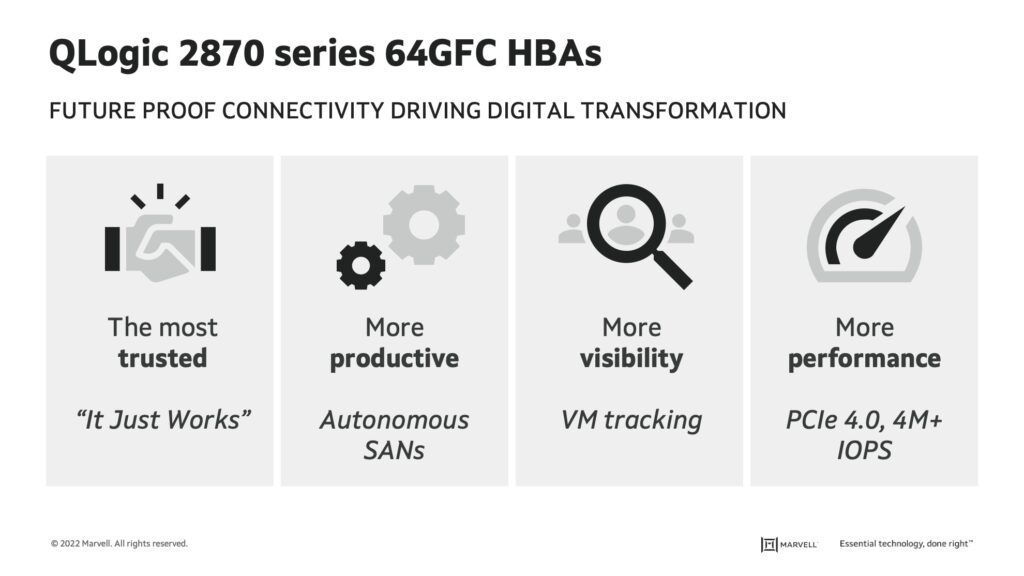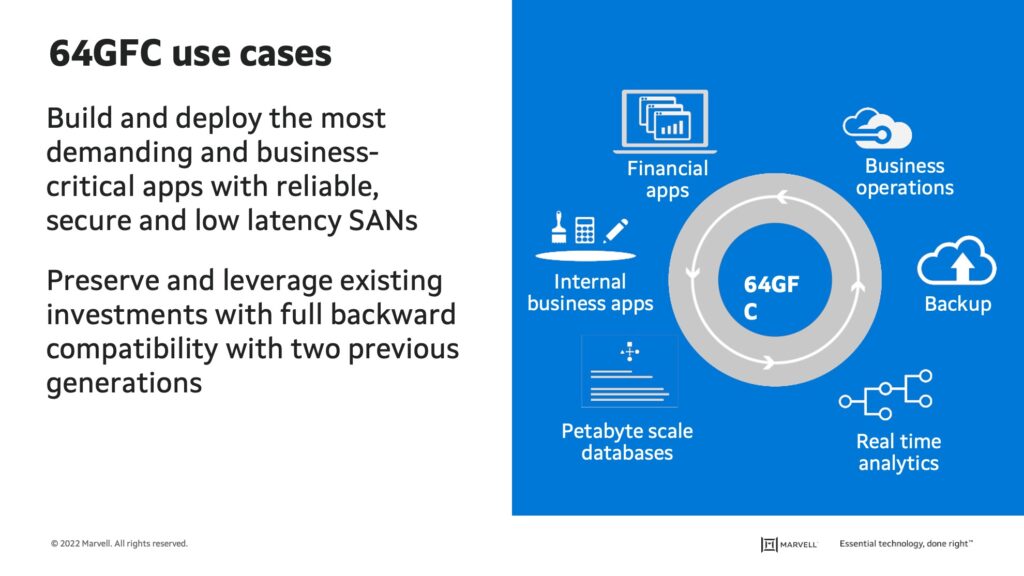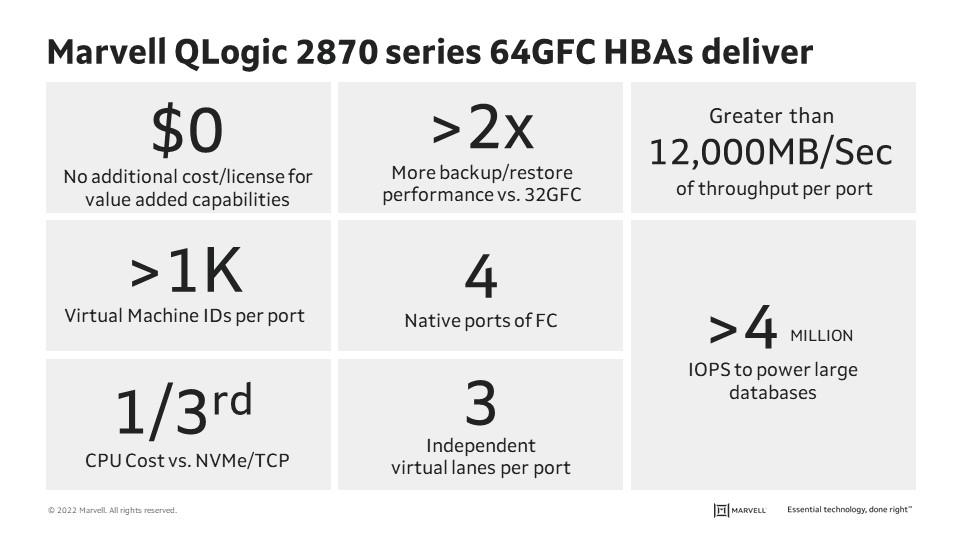- PRODUCTS
- COMPANY
- SUPPORT
- PRODUCTS
- BY TYPE
- BY MARKET
- COMPANY
- SUPPORT
The Tasting Notes for 64G Fibre Channel
While age is just a number and so is new speed for Fibre Channel (FC), the number itself is often irrelevant and it’s the maturity that matters – kind of like a bottle of wine! Today as we make a toast to the data center and pop open (announce) the Marvell® QLogic® 2870 Series 64G Fibre Channel HBAs, take a glass and sip into its maturity to find notes of trust and reliability alongside of operational simplicity, in-depth visibility, and consistent performance.
Big words on the label? I will let you be the sommelier as you work through your glass and my writings.
Most Trusted: Leveraging over two decades of experience and expertise developing QLogic Fibre Channel adapters, the single, dual and quad port PCIe 4.0 QLogic 2870 Series of 64GFC HBAs extend the battle-hardened dual port isolation architecture to deliver line rate 64GFC performance with full offloads. This improves response times for business-critical applications without burdening the server processor. Businesses that rely on block storage connectivity to deliver secure, reliable, and predictable high-performance to high end applications like peta-byte databases, financial applications, and real-time analytics continue to choose Fibre Channel (FC) connectivity. Purpose-built for connecting servers to shared-storage arrays, FC is the choice for over 70 percent of All Flash Arrays* and with over 150Million** ports shipped, will continue to remain the gold standard for block-storage connectivity in the private/hybrid cloud.
Autonomous SANs: Much has been written about the advent of new storage fabrics like NVMe/TCP and how recent standardization of concepts like the Centralized Discover Server (CDC) can bring a level of automation to an otherwise manual configuration process for Ethernet-based storage fabrics. What many of those articles don’t tell you is that Fibre Channel has been doing this for years, and FC HBAs automatically discover and connect to storage targets. Marvell QLogic 2870 series 64GFC HBAs extend the concept of an autonomous storage fabric with technologies like Fabric Notifications (FPINs) that enable the QLogic FC HBAs to look at the road ahead, be aware of potential roadblocks (like link integrity errors) and automatically select a more optimal path to the storage device, enabling consistent application performance.
VM Tracking: In a typical VMware ESXi virtual server deployment, IOs from all the VMs on the host are combined into a single stream by an HBA and sent to the switch in the fabric. There is no way for the switch to know which VM is sending which packet, and the SAN administrator cannot monitor traffic to gain visibility into the storage traffic patterns. Marvell QLogic VM-ID technology strengthens the datacenter capabilities for assisting virtualized infrastructures to monitor, manage and control the separate flows from end-to-end. Virtual Machine-ID (VM-ID) enables SAN and VM administrators to identify the “noisy neighbor” at the VM level. QLogic 2870 Series 64GFC HBAs from Marvell support VM-ID today, the solution is intelligent enough to work without requiring the storage array to be VM-ID aware and scales to over a thousand VMs per port.
Performance: For applications accessing shared storage, predictable performance is an absolute requirement. Workloads are not static and I/O demands can be very dynamic over time. QLogic 2870 Series of 64GFC HBAs are designed from the ground-up for in-order frame delivery, which is key to predictable performance and greater than 4Million IOPS for handling dynamic workloads. In addition, Marvell QLogic Universal SAN Congestion Mitigation technology works with a broad set of FC switches to detect and address network congestion automatically.
Use Cases for 64GFC: For IT Managers thinking about future workloads and the continued desire to get more out of their existing compute resources, this means assessing their existing storage network infrastructure and leveraging internal skillsets for the increasingly digital future.
In terms of FC HBAs, 32GFC has been around for three years and on the server side, we are now seeing 32GFC surpass 16GFC in terms of HBA host port volumes. This is primarily driven by the migration of enterprise storage arrays to all flash. As 32GFC storage arrays are now widely available and 64GFC storage arrays are not expected to be available until mid-to-late 2023, we expect most private cloud customers will continue to migrate to 32GFC over the next 2-3 years for mainstream applications and a smaller segment will choose to future-proof their server infrastructure with 64GFC. Marvell 2870 Series 64GFC HBAs preserve and leverage existing SAN investments by being automatically backward compatible with 32GFC and 16GFC switches. Business and mission critical applications that want to leverage the power of flash storage can future-proof their compute infrastructure today with QLogic 2870 Series 64GFC HBAs while they await the availability of 64GFC storage arrays.
The Marvell QLogic 2870 Series of 64GFC adapters deliver a performance optimized Fibre Channel HBA that has low latency and greater than 4 million IOPS enabling sustained peak performance of mission-critical enterprise applications. The Marvell QLogic FC technology goes beyond the numbers and maturity to deliver a satisfying storage connectivity experience!
In the Marvell QLogic 2870 Series 64GFC HBAs, I can taste the maturity and trust and I feel the lingering notes of reliability, simplicity, and performance. My quest for the perfect bottle of wine is over, how about you?
Learn how to order a bottle or a case, for the cellar or the next big dinner at www.marvell.com/QLogic.
*Marvell Estimates
** Quillin research https://www.prnewswire.com/news-releases/fibre-channel-industry-association-exhibits-next-gen-fibre-channel-technologies-at-flash-memory-summit-2022-301597085.html
Tags: 64GFC HBAs, 64GPS adapters, dual port isolation architecture, FC HBAs, FC switches, Fibre Channel, Qlogic 2870 series, QLogic FC HBAs, VM_ID Technoloy
Recent Posts
- Marvell Wins LEAP Award for 1.6T LPO Optical Chipset
- Co-packaged Optics: Powering the Next Wave of AI Data Center Innovation
- AI Scale Up Goes for Distance with 9-meter 800G AEC from Infraeo and Marvell
- Faster, Farther and Going Optical: How PCIe Is Accelerating the AI Revolution
- Marvell Wins Leading EDGE Award for Ara 1.6T Optical DSP
Archives
Categories
- 5G (10)
- AI (42)
- Cloud (17)
- Coherent DSP (11)
- Company News (102)
- Custom Silicon Solutions (8)
- Data Center (65)
- Data Processing Units (21)
- Enterprise (24)
- ESG (10)
- Ethernet Adapters and Controllers (11)
- Ethernet PHYs (3)
- Ethernet Switching (41)
- Fibre Channel (10)
- Marvell Government Solutions (2)
- Networking (42)
- Optical Modules (18)
- Security (6)
- Server Connectivity (32)
- SSD Controllers (5)
- Storage (22)
- Storage Accelerators (2)
- What Makes Marvell (45)
Copyright © 2025 Marvell, All rights reserved.
- Terms of Use
- Privacy Policy
- Contact


